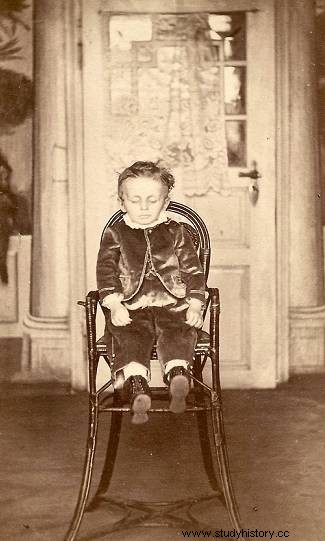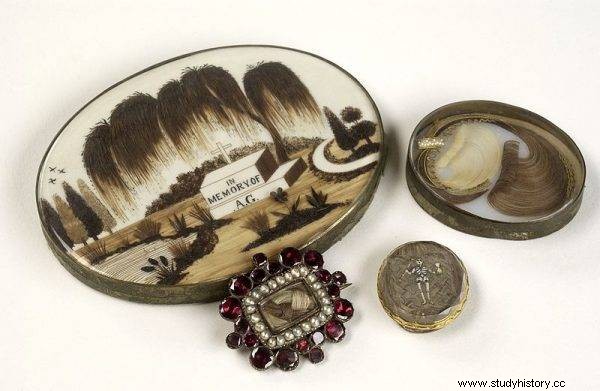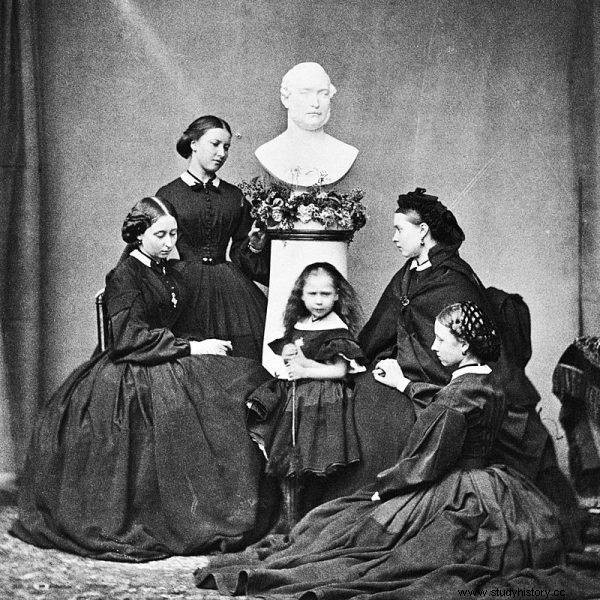With the death of Prince Albert, Queen Victoria plunged into the mourning that she endured for the rest of her life. She came to be called the Widow of Windsor, for she was the perfect example of a wife suffering from the loss of her husband. Her pain inspired the mourning practices that spread across the country, not only changing the perception of death, but also supporting the growth of the funeral industry on an unprecedented scale.
Death in the nineteenth century was a topic commonly present in the lives of all people, regardless of age and social status. Cholera, dysentery, typhoid fever or other diseases that are curable today, at that time often ended with the patient's death. In addition, there was a high percentage of women dying in childbirth, high mortality among children and poor sanitary conditions, both in hospitals and ordinary households.
People poison themselves unconsciously, for example by using cosmetics that contain deadly substances, or by using lead paints, e.g. for painting wooden toys. The most innocent objects turned out to be deadly tools.
As late as the end of the Victorian era in England, only 2 in 10 children lived to the age of two . These tragic statistics were caused, among others, by glass bottles with rubber hoses for milk, the specific structure of which makes feeding easier, but difficult to clean. They provided an ideal environment for bacteria and mold to grow, thereby increasing the number of infant deaths.
Adult statistics were also not optimistic. Many of them were under the age of 50. Therefore, early planning of your own death did not surprise anyone, and was even a common topic of discussions in the family circle.
Planning to die in life
During their lifetime, many people chose the place of their eternal rest, as well as the coffin or clothing in which they would be placed in the grave. Lots of women made their shrouds by hand and included them on the wedding trip. A short life determined the need to ensure a dignified burial, unfortunately it was associated with high costs and it became fashionable to set aside funds for a funeral early.
In the Victorian era, the industrial revolution began to rapidly increase the population of cities. In 50 years the population of London has increased from one million to over 2.5 million. Municipal plots were worth their weight in gold, so it was decided to move the cemeteries from the adjacent areas outside the city. Vast necropolises resembling parks were created, where residents spent their time walking, visiting the graves of their relatives . The nineteenth century also brought fashion for magnificent monuments and mausoleums, testifying to the status and wealth of the family. However, not everyone could afford such luxuries.

photo:public domain A mortal photography was also developing, presenting deceased relatives in more or less "alive" poses on film.
People from the social lowlands were often buried in simple, sometimes unplaned coffins, in less impressive parts of cemeteries. There were also burials in the so-called graves of beggars. These were deep pits that were usually left open for about four weeks until 17-18 bodies were buried in them. It was not customary to put soil between the coffins, with the exception of deaths from infectious diseases. Then some slaked lime and a thin layer of earth were placed to separate them.
The popularization of mourning and related customs also contributed to the flourishing of the funeral industry. It was a real golden age for funeral homes, gravediggers and embalmers. Mortal photography was also developing, presenting deceased relatives in more or less "living" poses on film. Department stores were also established, offering appropriate costumes and jewelery for the time of mourning. Its duration could be very long and follow different rules.
Black Crepe
The period of mourning depended both on the relationship between mourners and the deceased, as well as on the gender of those who mourn him. The women of their husbands were to mourn for at least two years. The time of mourning was then divided into two stages - full and half-mourning. During this period, the widow had to wear appropriate costumes, which over time changed from deep black to gray, then shades of violet and lavender.
The nineteenth century popularized crepe as a mourning material, used not only in costumes, but also in decorating houses, e.g. entrance doors. It was a signal for the outside world to behave appropriately when crossing the threshold and to respect the pain of the family.

The jewelery was often supplemented with the hair of the deceased, making eye-catching decorations or simply wearing medallions closed.
Women were allowed to wear jewelry, but also mourning ones. The most popular were ornaments made of jet, onyx or black enamel. The jewelery was often supplemented with the hair of the deceased, making them into effective decorations or simply wearing medallions locked in them . Widows were also expected to withdraw from social life for almost the entire period of mourning. They could only go to church freely.
Mournful etiquette
It was different with men. Their rules were less strict as many (especially the younger ones) were expected to remarry quickly. Their outfit also did not change rapidly. All they had to do was wear black gloves, a dark suit, and a black band around the hat.
The mourning wardrobe was a golden business, as there was a belief that after the mourning was over, it was necessary to get rid of all the costumes from the house, so as not to invite death into our doorsteps again . Many women, especially in high society, therefore had to buy new clothes every time, especially when it was going to be a long time of mourning.

In order not to get lost in all this, a special label was created that spoke of periods of mourning the dead depending on their relationship with the mourners.
In order not to get lost in all this, a special label was created that spoke of periods of mourning the dead depending on the relationship between them and the mourners. And so, apart from two years of mourning for widows, mourning parents or children should last one year, six months - grandparents and siblings, aunts and uncles only two months, great-grandparents six weeks, and first cousins four weeks.
While there were rules about how long to mourn the dead, there was no set date for ending the mourning. Many people took their time to close this stage and the people around them respected it.
Covered mirrors and bells by the graves
Although the nineteenth century brought the development of medicine and science, in many respects it was a time of strong belief in superstitions and fears related to burial. Doctors still found it difficult to obtain bodies for scientific research, which contributed to the popularization of corpse thieves who sneak into cemeteries under cover of night and dig up fresh graves . Many conditions were also not well known, and there were occasions when a doctor mistakenly considered someone dead. They were often people in comas who woke up in graves.
To avoid this type of situation, guards were placed at the graves, and relatives were buried with a rope tied to the hand, the other end of which was attached to the bell above the grave. Coffins with tubes and mirrors were also constructed, allowing gravediggers to peek inside for movement.
There were also superstitions that were supposed to both ensure a peaceful rest for the deceased and protect the family. The dead were led out of the house upside down so that they could not "look back" and take the next person to the afterlife. In the house of the deceased until his funeral, all windows and mirrors were covered so that they would not trap his image. Clocks were also stopped at death to avoid bad luck, and photos of the deceased were turned downwards to protect loved ones from being possessed by the deceased's spirit.
